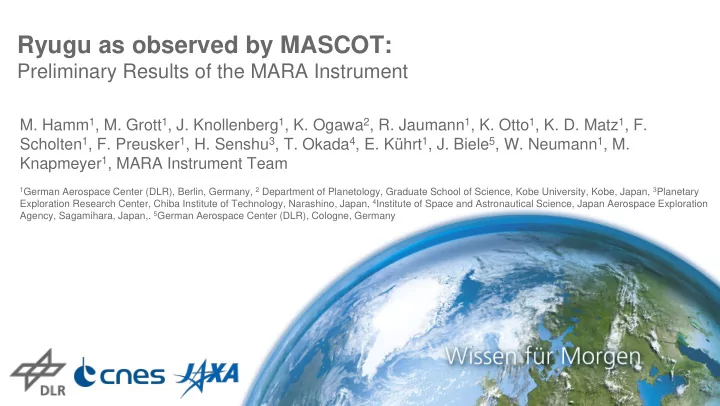

Ryugu as observed by MASCOT: Preliminary Results of the MARA Instrument M. Hamm 1 , M. Grott 1 , J. Knollenberg 1 , K. Ogawa 2 , R. Jaumann 1 , K. Otto 1 , K. D. Matz 1 , F. Scholten 1 , F. Preusker 1 , H. Senshu 3 , T. Okada 4 , E. Kührt 1 , J. Biele 5 , W. Neumann 1 , M. Knapmeyer 1 , MARA Instrument Team 1 German Aerospace Center (DLR), Berlin, Germany, 2 Department of Planetology, Graduate School of Science, Kobe University, Kobe, Japan, 3 Planetary Exploration Research Center, Chiba Institute of Technology, Narashino, Japan, 4 Institute of Space and Astronautical Science, Japan Aerospace Exploration Agency, Sagamihara, Japan,. 5 German Aerospace Center (DLR), Cologne, Germany
- Approximate field of view of MARA, steographic reconstruction of the 3D shape of the boulder is in progress
www.DLR.de • Chart 3 MARA During On-Asteroid Operations Deep Deep Diurnal Curve Space SDL Space
www.DLR.de • Chart 4 Temperature Measurement Uncertainty Brightness temperatures have bee calibrated using all in-flight data during cruise as well as the deep space views during on-asteroid operations. The 8-12 µm filter was found to be the best performing filter In general, brightness temperature errors are <1 K during daytime, but grow large for the narrow bandpasses during nighttime.
www.DLR.de • Chart 5 Illumination Model - The illumination model has been calculated based on the location of MASCOT at -22.30 ° N, 317.13 ° E - The orientation of the observed surface with respect to the local landing site orientation is unknown - Orientation of the surface normal is varied by ± 25 ° around the nominal surface normal. - Illumination is calculated by 𝐽 𝑛𝑏𝑦 ∙ 𝑜 𝑔𝑏𝑑𝑓𝑢 ∙ 𝑤 𝑡𝑣𝑜 - Sunrise and sunset have been adapted to fit the GNC sensors and the temperature data
www.DLR.de • Chart 6 Thermal Inertia - Best Fit - Data is fitted for nighttime temperatures after 11:00 UTC - Excellent fit during nighttime - Modelled daytime temperatures are higher than the observed ones - This can be a roughness effect
www.DLR.de • Chart 7 Thermal Inertia - Roughness - Roughness reduces the daytime fluxes for the MARA viewing geometries - We use a simple roughness model using spherical cavities - The model takes the viewing geometry into account but not vertical heat conduction
www.DLR.de • Chart 8 Thermal Inertia Estimate - Besides the various possible surface orientations, emissivity was varied from 0.9 to 1 and thermal radiation from the was modeled or ignored - for each of the above cases thermal inertia is fitted to the data, shown are those combinations with a sufficiently low 𝜓 2
www.DLR.de • Chart 9 Thermal Inertia Estimate - The assumed emissivity has a small influence on the obtained results ε = 1 - Acceptable fits result in thermal inertia ranging from 247to 375 J m -2 K -1 s -1/2 with a best fit for 282 J m -2 K -1 s -1/2 and an emissivity of 1 ε = 0.9
www.DLR.de • Chart 10 Thermal Inertia Estimate - Thermal radiation of the surrounding terrain will systematically increase temperatures throughout the day - Assuming 8% view factor to surrounding, ambient temperature same as observed brightness temperature, retrieved thermal intertia decreases down to 247 J m -2 K -1 s -1/2
www.DLR.de • Chart 11 Thermal Inertia Estimate - Thermal radiation of the surrounding terrain will systematically increase temperatures throughout the day - Assuming 8% view factor to surrounding, ambient temperature same as observed brightness temperature, retrieved thermal intertia decreases down to 247 J m -2 K -1 s -1/2 - Estimated thermal inertia range is a upper limit, stronger thermal radiation from the evironment would decrease the estimate
www.DLR.de • Chart 12 Estimated Thermal Conductivity and Porosity - Assuming a grain density typical for CI meteorites, s = 2420 kg m -3 , and a model of 𝑑 𝑞 we derive thermal conductivity 𝑙 𝜚 from thermal inertia - Comparison to three models of thermal conductivity based on meteorite samples to derive thermal conductivity and porosity of Ryugu - Large gap in the data for C chondrites
www.DLR.de • Chart 13 Lab Work -Thermal Conductivity Measurement Setup Coldfinger Sample Container -150 to +50 ° C Transient Hot Strip
www.DLR.de • Chart 14 Summary and Conclusions - MARA observed a full day-night at MASCOT site 2, looking at a boulder in its field of view - The best fitting thermal inertia of the boulder as derived from nighttime +93 J K -1 m -2 s -1/2 data is 282 −35 - The estimate will be refined considering thermal re-radiation, probably extending the lower errorbar - Current TI estimates indicate a highly porous boulder with = 28 - 46% - The low TI of small bodies may be unrelated to regolith cover. Rather, it could reflect the high porosity of surface boulders - We still need thoroughly investigate re-radiation and roughness when more 3D data is available from MASCAM
Recommend
More recommend